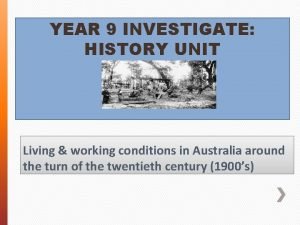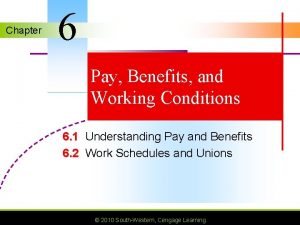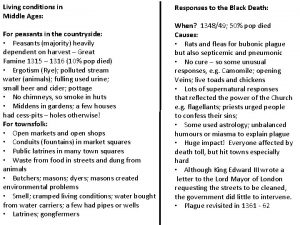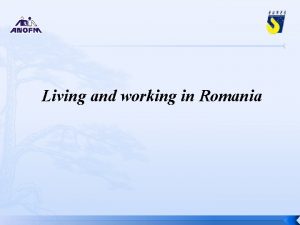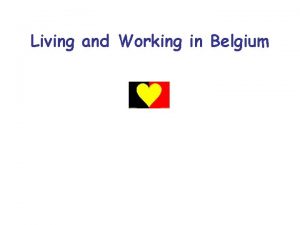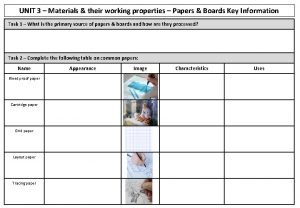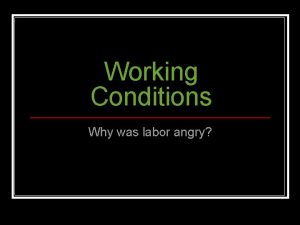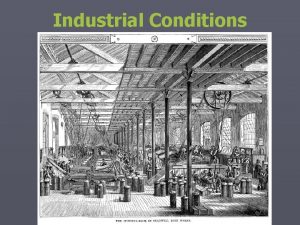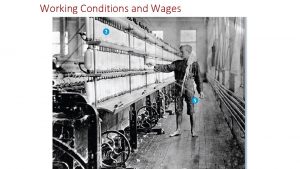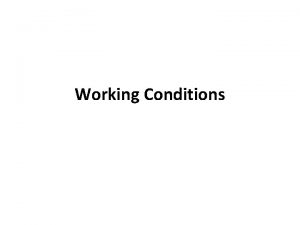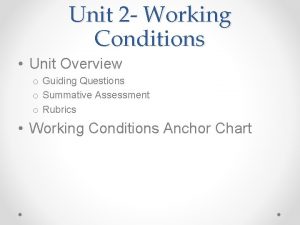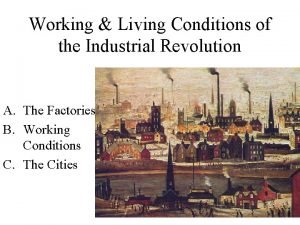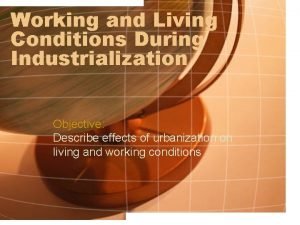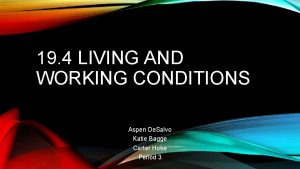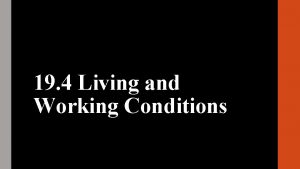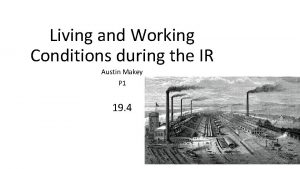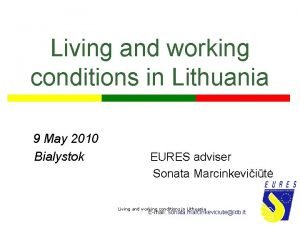YEAR 9 INVESTIGATE HISTORY UNIT Living working conditions
































- Slides: 32

YEAR 9 INVESTIGATE: HISTORY UNIT Living & working conditions in Australia around the turn of the twentieth century (1900’s)

» 1901 Census ØPopulation: 3. 7 million Ø 95. 9% Australian born ØWhite, English speaking ØAnglo-Saxon descent Who might be missing from this story? Who were Australians?

Half of Australians lived rurally and the other have inhabited towns. CENSUS NSW was the most populated State Three common forms of housing existed 1. Federation Style homes 2. Terrace houses 3. Slum areas People began to live in suburbs out of the main cities. AUSTRALIA IN THE 1900’S

Doesn’t the room look crowded? LIVING CONDITIONS OF HOUSING IN THE 1900’S IN RICHMOND, MELBOURNE

What about rural areas and indigenous Australians? Slums

HOUSING FOR THE POOR § § § The poor lived at the bottom of the hill in the ‘slums’ where they were regularly flooded and surrounded in pollution and diseases. The bottom of the hill was unsanitary and not safe and the houses were usually too small for those living in them. Houses were mostly prefabricated iron houses that were shipped from overseas. These houses were designed for people with near to no skills. Iron houses were extremely cold during the winter and extremely hot in the summer, however they provided somewhat adequate shelter for thousands. Families were squeezed into tiny houses near factories were they worked; people living in the slums generally struggled to pay rent and other necessities.

LOW PAY, CROWDED HOUSING When the world went through the industrial revolution factories and mass production was introduced, this meant that jobs were produced however resulted in pay being very low making it hard for families to pay for living expenses. Many houses provided shelter for more than 10 people, in houses that had only 2 rooms! Family sizes were extremely large due to the lack of contraceptives. All the above aspects made the quality of life low and also brought the house prices down dramatically.

LIFE-STYLE OF THE RICH IN THE 1900’S § § The rich lived at the top of the hill where it was rarely flooded and away from factories pollution. These houses for the rich would have many bedrooms, a kitchen and an inside toilet which would be cleaned on a regular basis. The richer families had a much less chance of catching many of the diseases that the lower class people did because their houses were much more sanitary but if there was a change of infection they could afford proper treatment, unlike the poor.

RICH HOUSES IN THE 1900’S Rich houses had separate bedrooms for adults and children an inside kitchen, laundry, sitting rooms and bathroom and also a clean garden. The rich had a much less chance of catching diseases as houses were much more sanitary, and if they happened to become sick they could afford proper treatment.

Affluence 1900’s style The affluent classes of Sydney in the early 1900 s usually lived in suburbs on the North Shore and the Eastern Suburbs. Unlike the inner-city terraces of the working class, the homes and the backyards of the middle and upper classes tended to be larger. Some homes even had a room for their servants, many of whom 'lived in. ' As the occupants of the homes were wealthier, proper sewerage and sanitation were also affordable.

Education in the 1900’s

Schools as we understand them, have existed in Australia for more than 200 years, beginning in NSW and expanding across the country as other settlements began. Public School systems did not begin until considerably later than this, beginning with primary level schools, then expanding into the secondary area beginning in the 1880 s. Universities first arose in the middle of the 19 th century, with early childhood education in the form of kindergartens and preschools lagging well behind all other sectors.

WHAT WAS SCHOOL LIKE IN THE EARLY 1900’S Have you ever wondered what school was like in the olden days? How different the classrooms, teachers and lessons were. . . and what the punishment was if you were bad? Click on the link to find out! http: //www. abc. net. au/btn/ story/s 2953658. htm

Work in Australia in the 1900’s

What about workers’ rights? Did they have any in the 1900’s? How old do you think that boy is? Do you think he has time for school?

It didn’t matter whether you were young or old, you had to help each other on the land

Life and working conditions in Australia at the turn of the century were harsh, dangerous and unsanitary compared with today's standards. Australia, however, had a reputation throughout the 19 th century as the ‘working man's paradise. ' This reputation was based on the adoption of the eighthour day and other benefits which were inconceivable in Europe. The Australian workforce adopted an 8 hour day in the late 19 th Century

Most manual labourers in the cities worked in factories. The factories were quite often poorly ventilated, without basic amenities, overcrowded and often reached over 40 degrees Celsius in summer, while being cold and damp in winter.

Most manual labourers worked in the city At the turn of the century, factories were very dangerous places. It was not uncommon for injuries to result from faulty machinery and a lack of safety equipment or protective clothing, which are mandatory at factory sites today.

Factory workers also had to work long hours. Rather than today's average working week of 40 hours, most people worked ten-hour days for six days of the week. Some even had to work overtime without being entitled to any extra pay.

The work of most women involved attending to their household duties and looking after their young children who were not of school age, while their husbands were at work. For those women and children who did enter the workforce, they belonged to Australia's working class. They had to endure similar working conditions to the men, except they did so with much less pay. They were restricted in the kinds of work they could do and were often teachers and nurses. Women received a wage 50 percent less than their male counterparts. As soon as a woman married, she was expected to give up her job. Women’s work was in the household looking after young children

Working-class children were also expected to help out the family by gaining employment. The majority of them left school at the age of twelve, but there were some children as young as eight who were working in a number of trades, such as textiles and boot factories. Children worked up to 60 -hour weeks and were paid around 2 -3 pence (2 c) an hour. » W Working class children

Transport in the 1900’s

Can you imagine a world without transport? Every day, people use all sorts of transport to move from place to place. Transport includes machines like buses, bicycles, cars, planes and trains. Transport also supplies shops with the products that people need and like to buy. The transport that people use today, however, looks very different from the transport that people used in 1900. This chapter will look at transport in the early 1900 s.

People living over 100 years ago in 1900 were seeing the rapid development of modern transport. Around 1900, many inventions were being developed that were making transport faster, more efficient and more comfortable than the existing forms of transport like the horse and cart

In Australia, over 4000 kilometres of railway tracks had been laid by 1890. Each capital city on the east coast was connected by railway lines and work had begun on developing suburban rail networks.

Horse or Bullock for transport In Australia, most of the movement of goods and passengers away from the rail network and train stations, particularly in the country, was still dependent on the horse or the bullock.

Ship Before air travel, the only way to cross the ocean was by ship. In 1900, the time taken to travel from England to Australia had been drastically reduced from about 140 days to 30 days with the invention of the steam ship.

Trains The first internal combustion engine-powered vehicle was designed by the German engineer, Karl Benz in 1885.

Trams As cities grew, the need for public transport increased. During the 1800 s, trams were developed as a means of transporting people. They were a faster and cheaper option than using a horse-drawn bus.

References: http: //www. skwirk. com/p-c_s-14_u-127_t-348_c-1203/life-and-working-conditions-/nsw/life-and-workingconditions-/australia-to-1914/life-in-australia-at-the-turn-of-the-century

Pick one of the following writing tasks TASK 1 Imagine you are going to school in the year 1900. Write 300 words. Firstly consider rural working lives, then compare with the poorer suburbs of cities. What were their homes like? What were working conditions like? How were their health and education affected by low wages?
 Living and working conditions in australia 1900
Living and working conditions in australia 1900 Lesson 4: parameters and return make
Lesson 4: parameters and return make What is the smallest living unit of life
What is the smallest living unit of life What does oedipus ask creon
What does oedipus ask creon Finding initial rate of reaction
Finding initial rate of reaction How to investigate a problem
How to investigate a problem Bivariate measurement data
Bivariate measurement data Investigate reflection
Investigate reflection Computer programer job description
Computer programer job description Psikologi kerekayasaan
Psikologi kerekayasaan Working conditions during the industrial revolution
Working conditions during the industrial revolution Fair working conditions
Fair working conditions European working conditions survey
European working conditions survey Chapter 6 pay benefits and working conditions
Chapter 6 pay benefits and working conditions European working conditions survey
European working conditions survey Living conditions in the middle ages
Living conditions in the middle ages Working smart vs working hard
Working smart vs working hard Hot hot
Hot hot Hot working and cold working difference
Hot working and cold working difference Differentiate between hot working and cold working
Differentiate between hot working and cold working Proses pengerjaan panas
Proses pengerjaan panas Living and working in romania
Living and working in romania Living and working in norway
Living and working in norway Living and working in belgium
Living and working in belgium Difference between living and non living organisms
Difference between living and non living organisms Is mold living or nonliving
Is mold living or nonliving Living non living dead
Living non living dead Y6 leavers poem
Y6 leavers poem Unit 10, unit 10 review tests, unit 10 general test
Unit 10, unit 10 review tests, unit 10 general test 30 pack year smoking history means
30 pack year smoking history means Pack year history
Pack year history Working in health and social care unit 2
Working in health and social care unit 2 Properties of foil lined board
Properties of foil lined board
